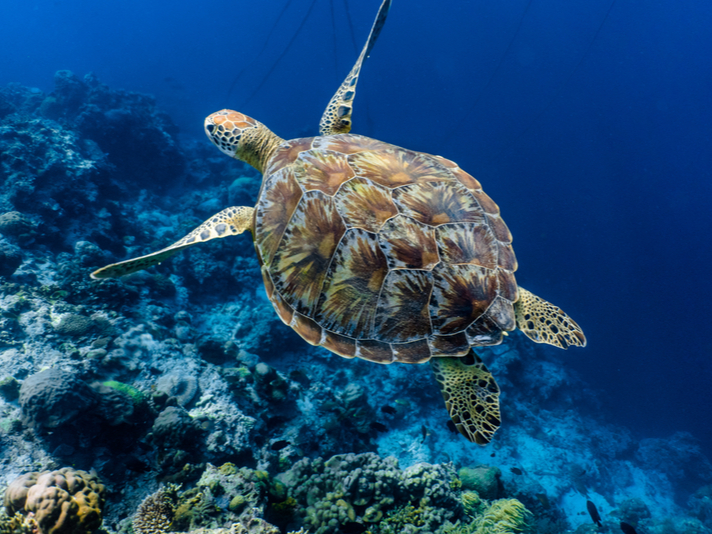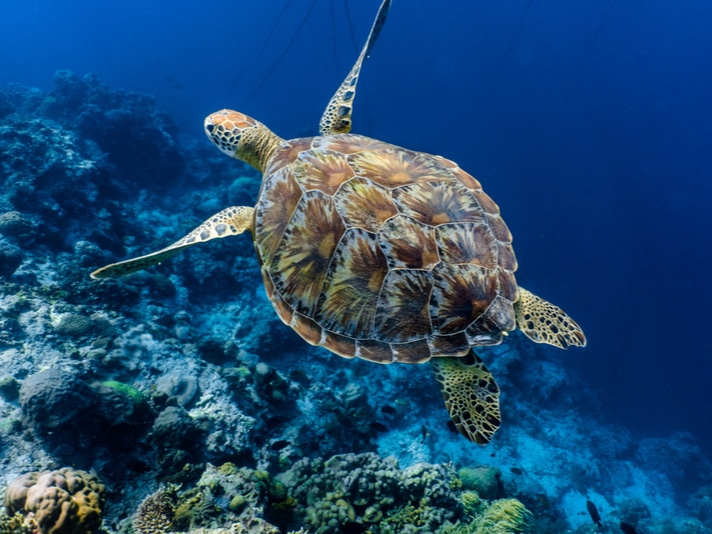Female green sea turtles on Raine Island outnumber males by 116 to 1.
The warming of the planet is turning one of the largest green sea turtle populations in the world into female majority turtles.

John Cuyos/Shutterstock
Female green sea turtles on Raine Island outnumber males by 116 to 1.
According to the study “Environmental Warming and Feminization of One of the Largest Sea Turtle Populations in the World” published January 8 in Current Biology, green sea turtles (Chelonia mydas) on the northern Great Barrier Reef, is home to one of the largest populations of female green sea turtles in the world, and apparently, on Raine Island, the offspring there for the last 20 years have been almost exclusively female. The island is home to one of the largest sea turtle nesting beaches in the world, and during the nesting season, more than 200,000 turtles come to deposit their eggs.
It is common knowledge in reptile science that warmer incubation temperatures yield more female turtles than males, but the researchers seemed to be in near disbelief when their study found that female green sea turtles on Raine Island outnumber males by 116 to 1.
“This is extreme—like capital letters extreme, exclamation point extreme,” turtle scientist Camryn Allen, with the National Oceanic and Atmospheric Administration in Hawaii told National Geographic. “We’re talking a handful of males to hundreds and hundreds of females. We were shocked.”
The researchers initially wanted to determine if climate change had already skewed the ratio of female to male green sea turtles. They used genetic testing to trace the sea turtles from one feeding area back to specific nesting sites.
“You work on one of the biggest turtle populations in the world and everyone tends to think that means things are good,” marine biologist Michael Jensen, the new study’s lead author and a research fellow with NOAA’s Southwest Fisheries Science Center in La Jolla, California told National Geographic. “But what happens in 20 years when there are literally no more males coming up as adults? Are there enough to sustain the population?”
Want To Learn More?
Temperature-dependent Sex Determination
Sand Color Influences Green Sea Turtle Egg Incubation
Jensen had to find a way to determine the sex of green sea turtles without resulting in invasive procedures, such as the use of laparoscopy. He turned to another scientist’s approach of using testosterone levels by drawing blood, to determine the sex based on hormone levels. Backup testing with via laparoscopy on a control group confirmed that the method worked. Their results were much worse than they had anticipated on that particular stretch of nesting area, the 80-acre Raine Island and nearby coral cays.
The researchers were also able to determine the approximate ages of the turtles that they had sampled, and found that when these turtles hatched in the 1970s and 1980s, females were the dominant offspring, but only at a 6 to 1 ratio. The researchers also sampled turtles on the southern portion of the Great Barrier Reef near Brisbane, where the temperatures have not increased as severely. The female turtles there outnumbered the male turtles at just a 2 to 1 ratio.
“This combined with some neat modeling shows that cooler beaches in the south are still producing males, but that in the more tropical north, it’s almost entirely females hatching,” Godley says. “These findings clearly point to the fact that climate change is changing many aspects of wildlife biology.”
Other factors are threatening the sea turtles of Raine Island, according to the researchers. Rising oceans have flooded nesting sites, and beach erosion is creating mini cliffs that make it nearly impossible for adult turtles to traverse, with many falling onto their backs and dying.
It is expected that in the next 35 years, the male female ratio of all seven sea turtle species will be skewed by global warming. Because their eggs are so temperature sensitive, producing entirely female offspring could wipe them out.
“The northern Great Barrier Reef is one of the largest genetically distinct populations of sea turtles in the world,” Allen said. “What’s really scary, though, is to think about applying this problem to populations where the numbers already are extremely low.”
The entire study can be read on the Current Biology website.


